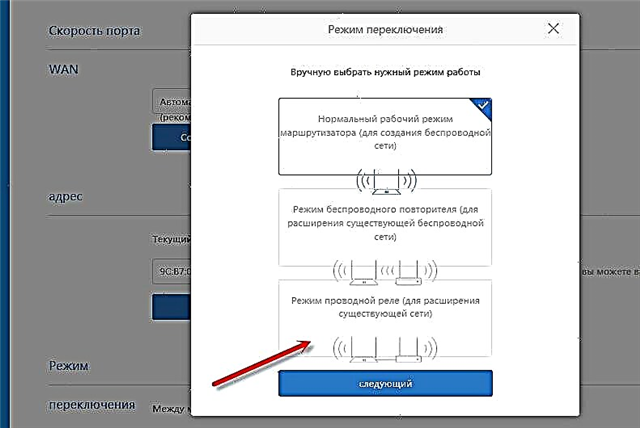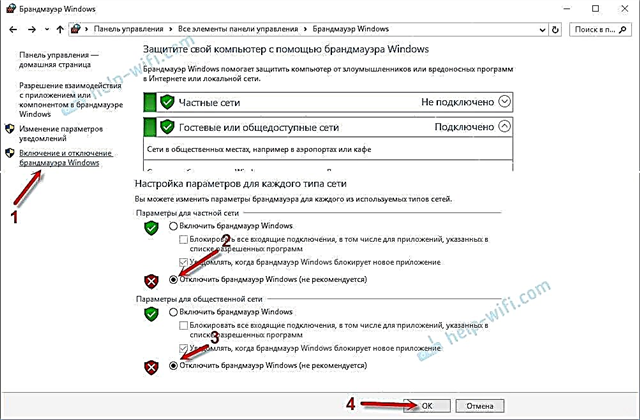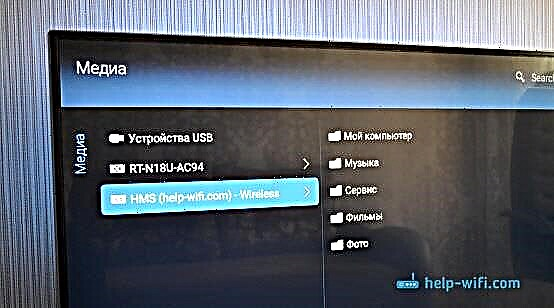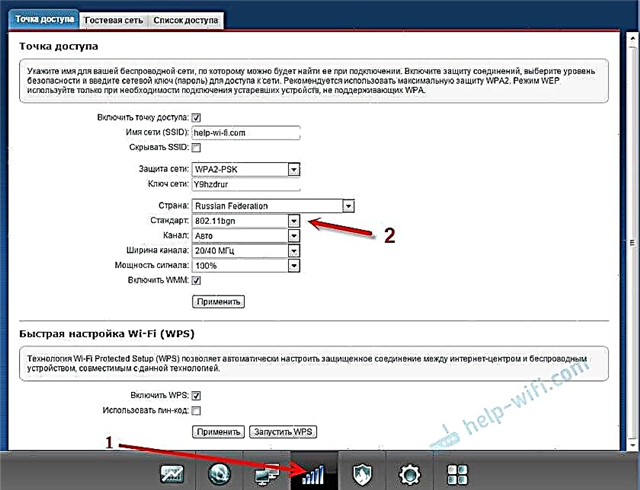One of the most important wireless settings is "Operation Mode", "Wireless Network Mode", "Mode", etc. The name depends on the router, firmware, or control panel language. This item in the router settings allows you to set a specific mode of Wi-Fi (802.11) operation. Most often, this is b / g / n mixed mode. Well, ac if you have a dual band router.
To determine which mode is best to choose in the router settings, you must first figure out what it is and what these settings affect. I think it will not be superfluous to take a screenshot with these settings using the example of a TP-Link router. For 2.4 and 5 GHz bands.
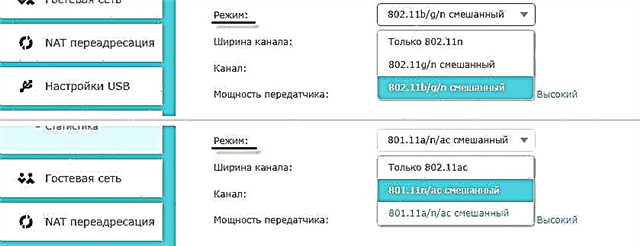
At the moment, there are 4 main modes: b / g / n / ac... The main difference is the maximum connection speed. Please note that the speed I will write about below is the maximum possible speed (in one channel). Which can be obtained in ideal conditions. In real life, the connection speed is much slower.
IEEE 802.11 Is a set of standards on which all Wi-Fi networks operate. In fact, this is Wi-Fi.
Let's take a closer look at each standard (in fact, these are Wi-Fi versions):
- 802.11a - When I wrote about the four main modes, I did not consider it. It is one of the first standards to operate in the 5 GHz band. The maximum speed is 54 Mbps. Not the most popular standard. Well, old already. Now in the 5 GHz range the ac standard already "rules".
- 802.11b - works in the 2.4 GHz band. Speed up to 11 Mbps.
- 802.11g - we can say that this is a more modern and refined standard 802.11b. It also works in the 2.4 GHz band. But the speed is already up to 54 Mbps. Compatible with 802.11b. For example, if your device can work in this mode, then it will easily connect to networks that work in mode b (older).
- 802.11n Is the most popular standard today. Speed up to 600 Mbps in the 2.4 GHz band (with 40 MHz channel width and three independent antennas). 802.11a / b / g compatible.
- 802.11ac - a new standard that only works in the 5 GHz band. Data rates up to 6.77 Gbps (with 8 antennas and MU-MIMO mode). This mode is available only on dual-band routers that can broadcast the network in the 2.4 GHz and 5 GHz bands.
Connection speed
As practice shows, most often the b / g / n / ac settings are changed in order to increase the speed of the Internet connection. Now I will try to explain how it works.
Let's take the most popular 802.11n standard in the 2.4 GHz band, when the maximum speed is 150 Mbps. This number is most often indicated on the box with the router. Also, there may be written 300 Mbit / s, or 450 Mbit / s. It depends on the number of antennas on the router. If there is one antenna, then the router works in one stream and the speed is up to 150 Mbit / s. If there are two antennas, then two streams and the speed is multiplied by two - we already get up to 300 Mbit / s, etc.
These are all just numbers. In real conditions, the speed over Wi-Fi when connected in 802.11n mode will be 70-80 Mbps. Speed depends on a huge number of very different factors: interference, signal strength, performance and load on the router, settings, etc.
Look, almost all routers, even on which 300 Mbit / s are written, the WAN port speed is limited to 100 Mbit / s. Well, no more squeeze. Even if your ISP provides 500 Mbps. Therefore, it is better to buy routers with gigabit ports. You can read my article where I talked about all the nuances in choosing a router.
More articles on the topic:
- Internet speed is lower on Wi-Fi. Why does the router cut speed?
- A router that does not cut the speed over Wi-Fi and gives 100 Mbps and more
- How to increase the speed of the Internet over Wi-Fi through a router
As for which mode of operation of the wireless network to set in the settings of the router and how this can affect the speed, I will tell you in the second part of this article.
Compatibility (router / client device)
All routers currently on the market can operate in at least three modes - b / g / n. If the router is dual-band, then also in 802.11ac.
Devices (or rather, built-in Wi-Fi modules): phones, tablets, laptops, TVs, USB Wi-Fi adapters, etc., also support certain standards. Almost all new devices that are currently entering the market can connect to Wi-Fi in a / b / g / n / ac mode (it is clear that the latter two are relevant). In both bands (2.4 and 5 GHz). Some individual models (for example, cheap laptops, smartphones) may not support the ac standard.
If we take, for example, an old laptop, produced in 2008, then there will be no support for the 802.11n standard (it appeared in 2009). Well, it is clear that they hardly immediately started installing modules supporting the new standard for all devices. New technology is entering the market gradually. As it happens now with the AC standard.
And if the laptop only supports Wi-Fi b / g, and our Wi-Fi network operates in "n only" mode, then our laptop will no longer connect to this network. Most likely, we will see an error Windows could not connect to Wi-Fi or Cannot connect to this network in Windows 10. And you can solve this problem by setting automatic mode (b / g / n mixed) in the router settings.
I recently ran into this problem myself. The Toshiba Satellite L300 laptop could not be connected to the ZyXEL router. All devices connected without problems, but the laptop did not. The error "Windows could not connect to ..." appeared. This is in Windows 7. At the same time, the laptop easily connected to the wireless network, which was distributed from the phone.
As it turned out, the 802.11n standard was set in the Wi-Fi network settings of the ZyXEL router. But the laptop is old and cannot work in n mode. Therefore, I did not connect. Complete incompatibility. After changing the router settings to 802.11 b / g / n, the laptop immediately connected.
B / g / n / ac in the router settings. Which mode to choose and how to change?
As a rule, automatic mode is set by default. 802.11b / g / n mixed, or 802.11n / ac mixed. This is for maximum compatibility. So that both a very old and a new device can be connected to the router.
I have not tested, but have heard and read more than once that setting 802.11n (Only n) mode for 2.4 GHz band, of course, allows decent increase wifi speed... And most likely it is. Therefore, if you do not have old devices that do not have support for 802.11n, then I recommend setting this particular standard for the wireless network. If there is such a possibility in the settings of your router.
And for the 5 GHz band, I would still leave the mixed mode n / ac.
You can always test. We measure the Internet speed on devices in mixed mode, then set "802.11ac only" or "802.11n only" and measure the speed again. Always save your settings and reboot your router. Well, don't forget which settings you changed. So that in case of a problem with connecting devices, you can return everything back.
Changing the Wi-Fi mode (mode) on your TP-Link router
In the TP-Link router settings, go to "Wireless" - "Wireless Settings".
Penu item: "Mode", or "Mode" depending on the language of the control panel.

If you have a TP-Link dual band router, then to change the operating mode of the 5 GHz band, go to the corresponding section.
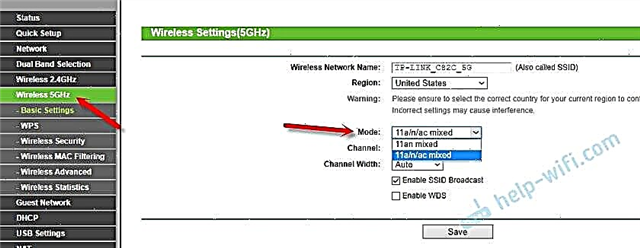
And a new control panel:
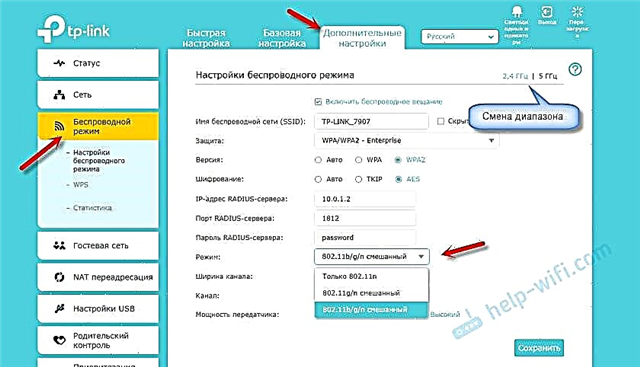
I noticed for a long time that on TP-Link, depending on the model and firmware, there may be different settings for the wireless network mode. Sometimes, for example, there is no "11n only" option. And there is only "11bg mixed", or "11bgn mixed". Which is not very convenient, since there is no way to set work in a certain mode to increase speed.
ASUS Router Wireless Mode
You can enter the settings of your ASUS router at 192.168.1.1. Next, open the "Wireless Network" section. This page contains the setting we need.

There are three options on my ASUS RT-N18U:
- "Auto" is b / g / n. Maximum compatibility.
- "N Onle" - work only in n mode, maximum productivity. No legacy device support.
- "Legacy" is when devices can connect via b / g / n, but the speed of the 802.11n standard will be limited to 54 Mbps. I do not advise you to put this option.
In the same way, we change the settings for a different range. Selecting "Frequency Range" - "5GHz" from the menu. But there I advise you to leave "Auto".
Changing the Wi-Fi network standard to ZyXEL Keenetic
Open the settings of the ZyXEL router and go to the "Wi-Fi network" section from the bottom. There you will see a drop-down menu "Standard".
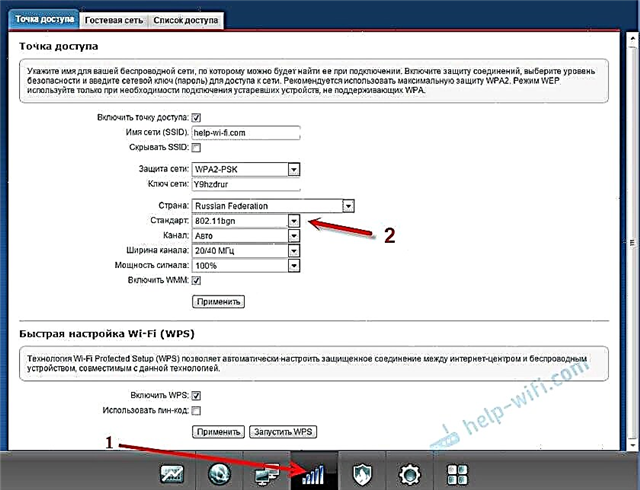
Do not forget to click on the "Apply" button after changing the parameters and reboot the device.
Wireless mode on D-link
Open the control panel of the D-link router at 192.168.1.1 (for more details in this article), or see how to enter the settings of the D-Link router.
Since they have many versions of the web interface, we will consider several of them. If in your case there is a light web interface as in the screenshot below, then open the "Wi-Fi" section. There will be a "Wireless Mode" item with four options: 802.11 B / G / N mixed, and separately N / B / G.
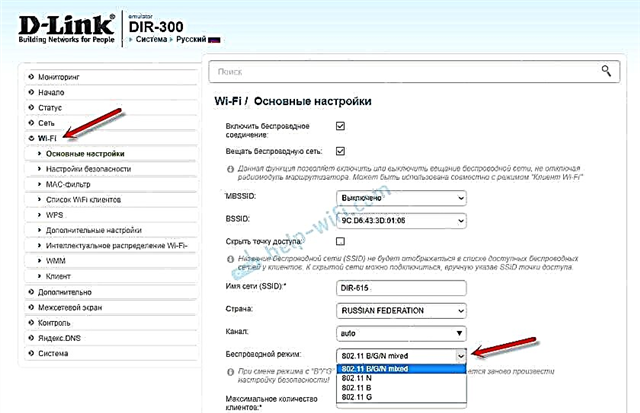
Or like this:
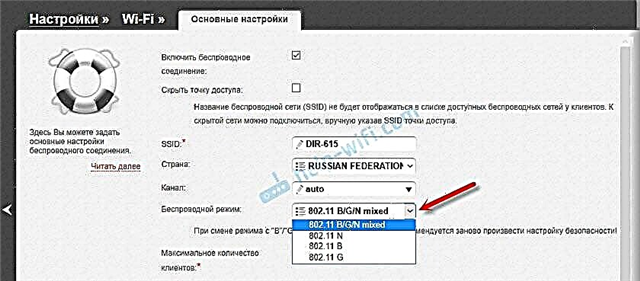
Or even like this:
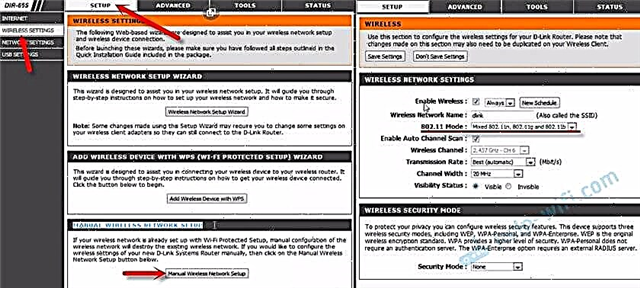
Configuring "802.11 Mode".
The radio frequency range on the Netis router
Open the settings page in a browser at http://netis.cc. Then go to the "Wireless Mode" section.
There will be a Radio Frequency Range menu. In it you can change the standard of the Wi-Fi network. The default is "802.11 b + g + n".

Nothing complicated. Just remember to save the settings.
Setting up a Wi-Fi network mode on a Tenda router
The settings are located under "Wireless Mode" - "Basic WIFI Settings".
Item "Network Mode".
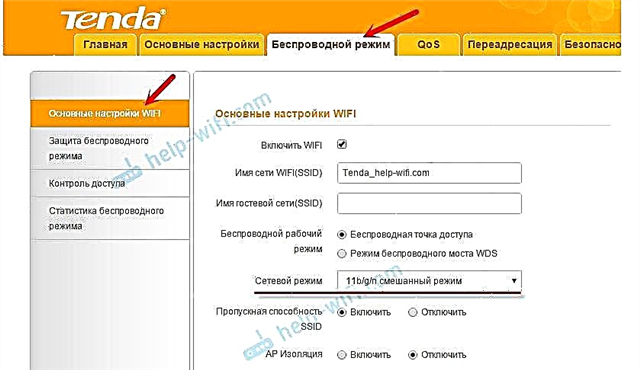
You can put both mixed mode (11b / g / n), and separately. For example, only 11n.
If you have a different router or settings
It is simply impossible to give specific instructions for all devices and software versions. Therefore, if you need to change the standard of the wireless network, and you did not find your device above in the article, then see the settings in the section entitled "Wireless network", "WiFi", "Wireless".
If you do not find it, then write the model of your router in the comments. And it is advisable to attach another screenshot from the control panel. I will tell you where to look for these settings.



